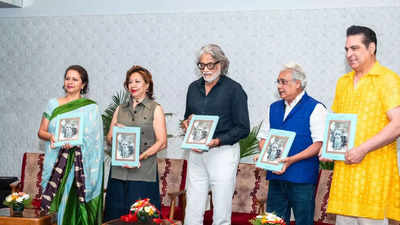The grand success of Sanjay Leela Bhansali's ' Heeramandi ' has brought the intriguing and the lesser-known lives of courtesans in the spotlight, yet agian. And now, a new book titled ' Ganika ' exploring the intriguing lives of tawaifs (courtesans) who played significant roles in the 19th and 20th centuries was launched on August 2, 2024, at The Park New Delhi. Edited by art historian Dr.
Seema Bhalla , 'Ganika' offers a detailed and refined understanding of these women, showing that they were far more than just performers. Talking about the new book, Dr. Bhalla said that it "challenges the typical images of tawaifs often seen in popular culture.

" She explained that the book provides a more realistic, honest portrayal of these women, who are frequently misrepresented in films. "This book explores different sides of these women, from their origins as devadasis to their roles in post-independence Hindi cinema," she added. The event began with a warm welcome from Rohit Arora, Vice President of The Park Hotels, North.
This was followed by an engaging panel discussion featuring prominent figures such as Priya Paul, Chairperson of Apeejay Surrendra Park Hotels; renowned filmmaker Muzaffar Ali , known for his classic ' Umrao Jaan ' (1981); Nawab Kazim Ali of Rampur; and Siddhartha Tagore, Founder of Art and Deal magazine. Each speaker shared their insights and perspectives on the cultural and historical significance of tawaifs in India. A notable topic of discussion was how modern portrayals, such as those in Sanjay Leela Bhansali's 'Heeramandi', often glamourise the lives of courtesans.
Dr. Bhalla stated, "Our view of tawaifs has been shaped by the luxurious images seen in movies, but 'Ganika' aims to tell a more truthful story." In reality, areas like Heera Mandi were poor and overcrowded, and the women faced significant challenges that movies often fail to depict.
One of the significant contributors to the book, Yatindra Mishra, explained that not all tawaifs had the luxury of owning the most expensive jewellery and wearing beautifully handcrafted sarees. This privilege was limited to only the most renowned courtesans, such as Gauhar Jaan and Begum Akhtar. He further emphasised the esteemed position tawaifs once held in society, remarking, "Rulers sent their children to tawaifs to learn manners and social skills.
These women were held in high regard," highlighting their roles as not just dancers and entertainers but also as teachers and cultural leaders. The discussion also covered how European influence shaped Indian art in the 19th and 20th centuries, particularly in the portrayal of courtesans. Dr.
Bhalla noted that the book blends Indian and Western artistic styles, stating, "This mix of cultures is a major theme in 'Ganika'." As the evening came to a close, guests engaged in personal discussions over cocktails and appetisers. The launch of Ganika was a notable success and a deeply meaningful event, effectively highlighting the authentic stories and experiences of tawaifs.
This book offers profound insights into India’s cultural history, presenting unique perspectives that make it an eye-opening read for anyone interested in understanding this rich and complex heritage. Robin Sharma on 'The Wealth Money Can't Buy', spirituality, writing, and more.



















